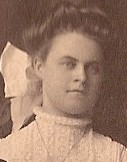Two women in the Norwalk High School Class of 1907 , Inez Adams and Alice McCammon, were selected for best grades in literary work. Unlike Irene Bragdon, who was honored in the best grades for regular work category, they did not venture into the male domain of oratory, but read essays, apparently the preferred feminine mode of expression.

Inez Adams
Inez Adams was one of the older members of the Class of 1907: nineteen at graduation. She came from a working class background; her father Martin was a foreman in a printing plant. So it was fitting, perhaps, that the cautionary title of her essay was “The Tendency of Luxury.”
“Wealth and its co-worker, luxury,” she proclaimed, “have made states, countries, and nations yield to them since the dawn of history.” She went on to condemn those who pursued riches, as an aristocracy contributing to downfall of America. Coming at the end of the “Gilded Age” this sentiment is understandable. She concluded forcefully with this warning, “if we cannot destroy the luxury that is ruining us, America will soon become like Rome was before her downfall.”

Alice McCammon
Alice McCammon was even older than Inez — she graduated at the age of twenty — and lived on a farm in Greenfield Township, where she had been born. Her essay was “Fashion vrs. Reason,” and like Miss Bragdon’s warnings about the dangers of pursuing wealth and luxury, hers was a cautionary tale about becoming a slave to fashion. She warned about following the crowd, and concluded by declaring that “one thing is always in fashion, good health.”
So what happened to these two young women? Inez Adams, like Irene Bragdon, never married. Soon after graduation, her family moved to Minnesota, where she began a life-long career as a stenographer with an insurance company. In her essay, she disparaged the pursuit of wealth, in her life, she followed her own advice. [3]
Alice McCammon also appears to have followed her own advice. She continued to live in Greenfield Township after graduation, becoming a teacher in a local school. In 1915 married a local farmer, and spent the rest of her life as a farmer’s wife. [4]
Footnotes:
[1] “Forty Seventh Annual,” The Norwalk Daily Reflector, June 13, 1907, page 1, column 3; “School Life is Ended,” The Norwalk Daily Reflector, June 15, 1907, page 1-2, column 6; and “Get Their Diplomas,” The Norwalk Evening Herald, pages 1,4.
[3] From the Inez Adams person page on the WeRelate Wiki.
[4] From the Alice McCammon person page on the WeRelate Wiki.
Thanks for visiting! Share and like this post below, and on Facebook. Let me know what you think in the comments. I’d love to hear from you!
Filed under: Alice McCammon, Inez Adams, Norwalk HS Class of 1907, Norwalk OH High School, Norwalk, Ohio, Uncategorized | Tagged: Adams Genealogy, Commencement Speakers 1907, McCammon Genealogy, Norwalk Daily Reflector, Norwalk Evening Herald, Norwalk High School, Norwalk High School Class of 1907, Norwalk Ohio History | 2 Comments »




 Today is Halloween, a holiday that was celebrated in 1906–but with a different twist than today. According to
Today is Halloween, a holiday that was celebrated in 1906–but with a different twist than today. According to  familiar today, like bobbing for apples. A variation of that game popular at the time was called “Snap Apple,” where boys and girls would attempt to bite an apple suspended from the ceiling by a string. The first to succeed would be the first to marry. Another game involved the host hiding a dime, a ring and thimble in mashed potatoes or a similar food. The guest who found the ring in his portion would be destined to marry soon, the one with the thimble would spend his or her or life alone, and the lucky one to get the dime would have good fortune. Of course, one would imagine that an unwary or impatient guest could end up needing dental work.
familiar today, like bobbing for apples. A variation of that game popular at the time was called “Snap Apple,” where boys and girls would attempt to bite an apple suspended from the ceiling by a string. The first to succeed would be the first to marry. Another game involved the host hiding a dime, a ring and thimble in mashed potatoes or a similar food. The guest who found the ring in his portion would be destined to marry soon, the one with the thimble would spend his or her or life alone, and the lucky one to get the dime would have good fortune. Of course, one would imagine that an unwary or impatient guest could end up needing dental work.





